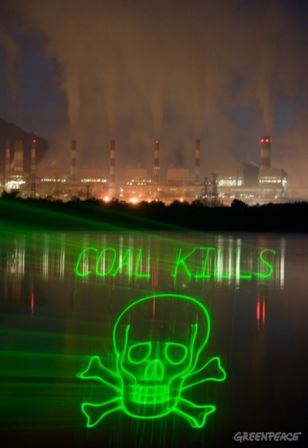
Greenpeace photo
MANILA – The fight against coal has always been a battle between David and Goliath. Stories from host communities themselves can attest to the fact that power, authority and deception are the tactics used to coerce people into “accepting” coal projects.
Energy is a burgeoning problem for the Philippines therefore the only way to address it is thru coal energy – a line that is often repeated by the Department of Energy.
The premise may be correct but the conclusion is absolutely wrong. The Philippines is rich in renewable energy. We need not look far or dig deep for coal when we have renewable energy whose fuel is virtually free and limitless.
Last August 23, Greenpeace along with anti-coal communities from Luzon, Visayas and Mindanao came together in a National Anti-Coal Summit ‘to raise their opposition to coal, reassert their rights to a safe and healthy environment, and to demand that the government reverse all coal projects immediately’. This initiative saw the formation of a Nationwide Anti-Coal Network, the Anti COALition and the signing of the Anti-Coal Manifesto.
COAL IS NOT CHEAP
The quest for energy has left our government scrambling for the “cheapest” option, which is coal. This myopic view that coal is cheap is not true. It only refers to the business cost and underestimates the construction cost, and cost overruns. Given the historic rise of the price of coal, due in large part to the direct correlation of oil & coal prices globally, we run the risk of putting ourselves hostage to price volatility.
The failure to assign a risk factor for coal-fired power plants where it is economically flawed shows that government as well as power producers have failed to understand the economic realities of coal energy. As the cost of finite fossil fuels continues to increase, renewable energy is becoming more competitive in an increasing range of circumstances & countries.
In developed countries, coal projects are quickly being cancelled and abandoned, as the upside-down economic model for coal-fired power has clearly been proven untenable. It has become clear that coal economics is deteriorating.
TRUE COST OF COAL
From mining, burning to disposal of coal, every link in the chain of custody causes irreparable damage to people and the planet. The true cost of coal, which is not included in the accounting ledger or business cost model of coal proponents, include climate change, toxic pollution, destroyed livelihoods, displaced communities, health effects on the respiratory and nervous systems, acid rain, smog pollution, water scarcity and reduced agricultural yields.
At the centre of it all, bearing the brunt of the impacts and the costs are the host communities – the marginalized sections of society who live near power plants that are affected.
Communities from existing coal-fired power plants in the Philippines have seen the dire effects of coal. In the beginning, coal proponents come in as bearers of hope with promises of employment and a better life. However, apart from the basketball courts, barangay clinics and fiestas that they sponsor, they leave nothing but devastation and destruction in their wake.
Greenpeace conducted a study on fly ash from 5 coal-fired power plants in the Philippines. The results show the presence of toxic elements such as aresnic, chromium, lead & mercury that can cause poisoning, cancer, neurotoxicity and developmental effects in the fetus.
It may sound cold-hearted to weigh a human being’s life against the cost of a product, even one as valuable as electricity – but that is what it all boils down to. The pollution and irreparable damage from coal-fired power plants impose significant social costs that far outweigh the retail value of the electricity from coal.
COAL LOCK-IN
These coal plants would lock the Philippines into three to four decades of reliance on this dirty and harmful fossil fuel. Coal contravenes the Renewable Energy Law. Every coal power plant built prevents renewable energy projects from taking off, with coal taking over the demand in the market that could otherwise have been supplied by RE.
DOE has said that RE will be mainstreamed only by 2017. Why wait until 2017 when these can be developed and harnessed today? By then, coal projects would’ve locked us to a lifetime of coal, thereby edging out opportunity for renewable energy to flourish.
COAL IS EQUALS TO CLIMATE CHANGE
Coal fired power plants are the biggest source of man-made CO2 emissions, making coal energy the single greatest threat facing our climate.
In 2011, the Philippines topped the list of most disaster prone countries in the world, following the weather-related calamities which claimed over 3,000 lives, affected 15.3 million Filipinos, and resulted in economic losses of over 26 billion pesos. It is a narrative that we have all become familiar with – what we are experiencing now is the ‘new normal’.
The Philippines is one of the most vulnerable yet least prepared to deal with the anticipated and escalating impacts of climate change – the greatest humanitarian and environmental threat the world faces today.
While it is true that the industrialized countries have the greatest share of responsibility to avert the climate crisis, it should not be construed as an excuse for developing countries to continue “mimicking the destructive path that is pushing the climate to a tipping point the world may never recover from”.
GO RENEWABLE
For the Philippines, Greenpeace sees a target of 50% RE by 2020. It is ambitious but realistic. This is a golden opportunity for the government, particularly the Department of Energy, to implement and enforce the Renewable Energy Law. It is also the main agency responsible for translating the vision of the National Renewable Energy Plan into reality.
President Aquino, who has committed to phase out of coal and the immediate implementation of the Renewable Energy Law, said that renewable energy will fuel our future. The decisions being made by Energy Secretary Almendras must be mindful of delivering the commitment made by the President. If he cannot implement the RE Law and phase out coal, then he is doing a disservice not only to the President, but to the Filipino people who are his “bosses.” As a public servant he should be serving the interests of the people, and not the coal industry. If he cannot be held accountable to uphold the interests of the Filipino people, then he must make way for a visionary leader who will make this sustainable future possible for the Philippines. (By Anna Abad. The author is a climate and energy campaigner at Greenpeace SEA-Philippines.)

